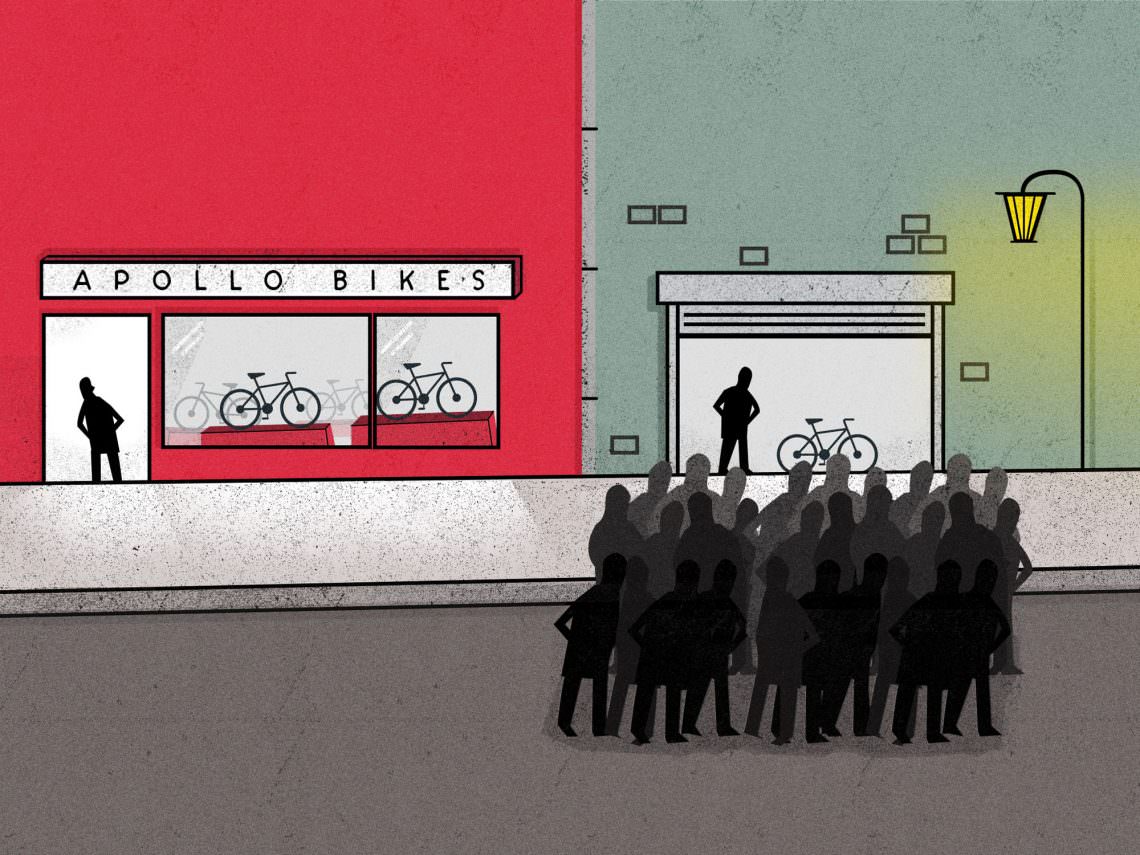Why do we always root for the underdog? Why does success mean selling out?

I still remember the first time I saw the film Rocky, the iconic story of a barely coherent Rocky Balboa, a working-class boxer overcoming all the odds to stand victorious. Damn, as a kid I near burnt that VHS out. His opponent was heavyweight champion Apollo Creed; Apollo had it all, the money, the house, the women, the glamour, a huge success by all accounts. So why was it, sitting watching the film as a teenager with friends, we hated him? We did not know why, but we hated him! As the film reached its climax, Rocky delivering his final flurry of uppercuts, we were in that ring with him, leaping around the room air-punching in fervoured excitement. “Come on Rocky, you can do it!”
Go for the ribs, don’t let that bastard breathe Mickey Goldmill [Rocky’s trainer]
There has always been champions and underdogs. It’s no different in the bike industry; there’s a given respect for the guy who welds up steel frames in a small workshop, sweating in the confined space listening to AC-DC, open beer on the workbench, final-demand bills clipped to the notice board. A good man, doing it for the love, the heart of bike building, the people’s champion! Small brands gain almost cult like status, producing small runs of bespoke frames and speaking directly to their customers on FaceBook. They all hope one day to make it, to become successful, to take on more staff and to see their bikes all over the world; but as soon as they become successful and gain bigger resources, well, we just don’t like them anymore. “What’s that? A [insert big brand here], Nah, it’s not for me? They are just too mainstream.”
We can’t help it though, it’s human nature, and it has been proven on many occasions. One scientific study found, when presented with two fictitious teams playing each other in a series, 88% of the test panel chose to support the one described as the underdog. Funnily enough when presented with new evidence that the favourite had lost the first three games, over half of that 88% switched their allegiance. Humans are fickle, it’s the struggle that fascinates us. There is something about the underdog identity that see us think they ‘deserve’ to win against the odds. One study even showed that when students were shown simple circles placed on an incline they “prefered and sympathized more with them”, over the arrogant non-struggling circles on the flat. How crazy is that!
While winning is valued, cross-cutting values often create sentiments for the underdog, that is, the desire for the underdog to overcome the inferior status and upset the favored opponent. [The Underdog Concept In Sport]
Of course there are benefits for a brand being small, such a brand can be reactive to market trends and new developments. Being small means a brand can have a very close relationship with its potential and existing customers. If a brand only produces one bike model it can make sweeping changes year on year. The industry giants simply cannot do that, new designs take years to prepare to roll out in sufficient volume. If a brand has a portfolio filled with hundreds of bike models, they cannot simply change one dramatically to meet new trends, each model needs to be in balance with the rest of the lineup, harmony, restraint, no gambling. However, the biggest players have far greater resources at their disposal, able to drive pricing and develop cutting edge designs. In the end we need both, we need the champions to satisfy global demand, push awareness and encourage new riders into the sport, and we need the maverick underdogs, the gamblers, reactive enough to keep the giants on their toes.

Where do all these preconceptions come from? If forums are to be believed, propaganda tells us that big brands pluck their designs from a soulless computer algorithm, intent on serving up vanilla bikes. Of course, in some cases this can be true, some brands have become so successful that they have lost touch with the sweat and dirt, now measuring success only in money and sales targets. But the fat-cats are still in the minority, in most cases, when you meet the guys from the design teams of the big players face to face, you find passionate riders who race at the weekends, head out on lunch time rides and wear five-tens under their desks. It’s something we see on our channels too, if we favour a bike from one of the super companies over a smaller – dare we say it cooler – brand, we get a social media hammering. Looking at some of the comments on our FaceBook feeds you would think we spend our working days suckling from the teats of the industry giants, kicking back, feet up on our marble desks while we sign for sacks full of cash bribes delivered by UPS. In the real world, we’re just like you, we just want to ride the best bikes on the best trails.
Every champion was once a contender who refused to give up. [Rocky Balboa]
Don’t get us wrong, we love an underdog too, but it’s easy to forget that the superbrands grew to size they are for just one reason, they make really great bikes. With huge resources and some of the best designers in the business they continue to be the bikes to beat in most tests. To be a champion you have to work, and success is always hard earned, but with great success you become the Creed to the Balboa. We all love to hate the man, but it’s OK, it’s just human nature.
This article is from ENDURO issue #033
ENDURO Mountainbike Magazine is published in a digital app format in both English and German. Download the app for iOS or Android to read all articles on your tablet or smartphone. 100% free!

Words: Trevor Worsey Illustration: Julian Lemme
Did you enjoy this article? If so, we would be stoked if you decide to support us with a monthly contribution. By becoming a supporter of ENDURO, you will help secure a sustainable future for high-quality mountain bike journalism. Click here to learn more.











